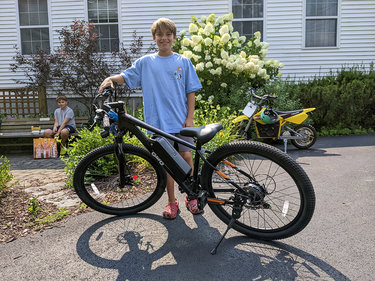As use of e-bikes explodes, municipalities can regulate their use
The Enterprise — Melissa Hale-Spencer
Careful cyclist: Daniel Long, 12, poses with his new e-bike on Tuesday afternoon near the Methodist church in Voorheesville where he and his friend were enjoying a picnic. “I’ve only ridden it 10 times,” said Long, who easily explained the intricacies of how his bike works. His helmet was at hand on the handlebars.
ALBANY COUNTY — With electric bike use “exploding all over the village,” Trustee Jack Stevens said during a recent village board meeting, “sooner or later,” Voorheesville is going to “have to come up” with a way of dealing with e-bikes.
Stevens said there had been a recent incident near the corner of Scotch Pine and Locust drives, where a young rider “came around the corner hard and ran right into the side of a car door.”
Deputy Clerk Barbara Maughan said that, earlier that day, July 22, there had been a group of riders “zooming around” Hotaling park, “beeping the horn quite a bit.” Then, when she went to the village’s bank, Ballston Spa National Bank, Maughan saw a group of e-bikes near the intersection of Circle and Scotch Pine drives, “in the middle of the street.”
Maughan said they were “going really fast.”
While a 2020 state law establishes a classification system for electric bikes and scooters, it has no requirements for registration, licensing, and insurance. Rather, individual municipalities can make their own rules although few in Albany County have.
At the same time, the Voorheesville discussion reflects two widespread trends:
— Use of e-bikes has steadily increased in recent years because they offer commuters a cheaper and more environmentally friendly way to travel; and
— Safety concerns have arisen as use increases.
State rules
New York state first established a legal framework for electric bikes and scooters in 2020, creating a three-tier classification system to distinguish e-bikes and e-scooters from other motor vehicles.
The New York Vehicle and Traffic Law defines two main device categories:
— Electric scooter
A device with handlebars, a floorboard or seat, and an electric motor. It may be powered by the motor and/or human effort, weigh under 100 pounds, and cannot exceed 20 miles per hour on a level surface when powered solely by the motor; and
— Bicycle with electric assist (e-bike)
A “bicycle with electric assist” whose motor output is less than 750 watts, includes fully operable pedals to distinguish it from other motorized vehicles, and is not more than 36 inches wide. Additionally, e-bikes are required to adhere to all equipment and manufacturing standards established by the United States Consumer Product Safety Commission.
E-bikes must also fall into one of the following three categories:
— Class 1, pedal-assist
A Class 1 e-bike, per state law, is defined as a “bicycle with electric assist having an electric motor that provides assistance only when the person operating such bicycle is pedaling, and that ceases to provide assistance when such bicycle reaches a speed of twenty miles per hour.”
Class 1 devices are often considered the most analogous to traditional bicycles, as they require rider effort to engage the motor.
— Class 2, throttle-on-demand
A Class 2 e-bike is considered a “bicycle with electric assist having an electric motor that may be used exclusively to propel such bicycle, and that is not capable of providing assistance when such bicycle reaches a speed of twenty miles per hour.”
The key feature of a Class 2 e-bike is its throttle, which allows the rider to power the bike without pedaling, similar to a scooter or moped.
— Class 3, high-speed
Class 3 e-bikes are defined as bicycles “with electric assist having an electric motor that may be used exclusively to propel such bicycle(s), and that is not capable of providing assistance when such bicycle reaches a speed of twenty-five miles per hour.”
Class 3 e-bikes are subject to a geographic restriction: They are only permitted to be used within a city having a population of one million or more, which means only in New York City.
In addition to operational rules, the state regulation includes specifics on rider age and equipment necessary to operate an e-bike. For example, to legally operate any class of e-bike in New York state, a person must be at least 16 years of age.
But the rules also vary based on a combination of e-bike class and operator age:
— For riders aged 16 and 17, helmets are mandatory when operating any class of e-bike:
— For Class 1 and Class 2 operators over the age of 18, wearing a helmet is not mandatory; and
— For all Class 3 operators, helmet use is mandatory regardless of age.
Following adoption of the 2020 law, there was a dramatic increase in the number of fires caused by the lithium-ion batteries that propel e-bikes.
In response, the state legislature adopted a series of laws in 2024 that:
— Prohibit the sale, lease, or rental of e-bikes and their batteries unless they had been certified by an accredited testing laboratory;
— Place a handful of direct responsibilities on retailers, including having to provide customers with an operating manual detailing safe battery charging, storage, and maintenance; and
— Require law enforcement personnel to investigate and file a formal report with the state’s Department of Motor Vehicles for any accident involving an e-bike or e-scooter that resulted in serious injury or death.
Home rule
One cornerstone of the 2020 legislation was to exempt e-bikes from state-level requirements for registration, licensing, and insurance.
The law granted e-bike operators all of the rights, duties, and obligations applicable to riders of traditional bicycles, including obeying traffic signals and signs, riding with the flow of traffic in the rightmost lane, and using proper hand signals for turns.
Another key piece of the 2020 legislation granted authority to local municipalities to enact their own e-bike ordinances, resulting in a complex, often more restrictive, series of patchwork rules across the state.
While none of the eight municipalities in The Enterprise coverage area — Guilderland, Altamont, New Scotland, Voorheesville, and the four Hilltowns — have e-bike laws on the books, a handful of cities, towns, and villages in Albany County have enacted regulations, including the county itself.
In 2021, county legislators adopted the Albany County Electric Scooter and E-Bike Helmet Law, which mandated that “any individual operating or riding as a passenger on a bicycle with electric assist shall wear a helmet.”
The rule also applies to e-scooters.
Violating the requirement is punishable by a fine up to $100, which can be waived if the violator obtains a proper helmet before his, her, or their court appearance.
The law is applicable to all municipalities within Albany County, unless a city, town, or village has its own stricter rule. Other than the 2021 law, there are no e-bike and scooter prohibitions on the county-owned Helderberg-Hudson Rail Trail.
The town of Colonie in 2022 adopted a local ordinance prohibiting most e-bikes on its park trails, in particular “motorbikes, minibikes, motor vehicles and class 2 and class 3 E-Bikes, as defined by New York State Vehicle and Traffic Law, are prohibited from all Town bicycle paths.” Colonie’s 2022 law did not specifically prohibit pedal-assisted Class 1 e-bikes.
Though it does not explicitly state e-bike or e-scooter, because they weren’t around at the time, the village of Colonie has had a rule on the books since 1995 that states, “All persons are forbidden to ride, drive or propel any motor vehicle, motorcycle or motorized bicycle on or over any of the bicycle paths, bikeways or bike lanes designed, designated for or devoted to bicycles in the village.”
This year, the city of Albany incorporated state language on e-bikes and scooters into ordinances to update zoning that previously referenced horse-drawn carriages and velocipedes.


